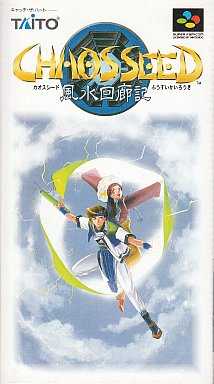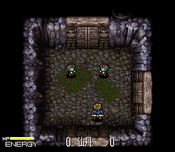Chaos Seed
| Chaos Seed | |
|---|---|
 Cover art (Super Famicom) | |
| Developer(s) | Neverland[1] |
| Publisher(s) | Taito[1] |
| Designer(s) | Junichi Kashiwagi |
| Composer(s) | Yasunori Shiono Katsuhiro Hayashi Yukio Nakajima[2] |
| Platform(s) | Super Famicom[1] Sega Saturn[1] |
| Release date(s) | Super Famicom: Sega Saturn:
|
| Genre(s) | Role-playing video game |
| Mode(s) | Single-player |
| Distribution | Cartridge CD-ROM |
Chaos Seed (カオスシード)[3] is a role-playing video game that also combines elements of action games and strategy video games. This game was released in 1996 for the Super Famicom and in 1998 for the Sega Saturn in Japan only. Fans are currently working on an English translation patch for the SNES version.
Gameplay

Players control a young member of a cave-dwelling faction of humans as they try to harness energy back into the dying planet that the surface-dwelling humans take for granted. Explorers and adventures want to raid these mystic rooms inside the "dungeons" that the cave-dwellers refer to their homes.[1]
As players freely explore their surroundings, they can manipulate the walls to make the necessary mystic rooms that are important to winning the game. Monsters can be summoned and upgraded by simply channelling pure energy into the Earth. Magical spells from creatures who can use magic in addition to weapons from the warrior-caste monsters are used to defeat the greedy explorers and adventurers from the overworld. After creating a certain amount of energy, the player simply moves on to the next level. Spirit rooms play a role in being able to summon more advanced creatures and acquiring the other resources necessary to playing this game. Bonuses and upgrades are granted to player upon accomplishing certain feng shui-related tasks.[1]
Certain non-player characters may help or hinder players depending on their actions throughout the game.[1]
References
- ↑ 1.0 1.1 1.2 1.3 1.4 1.5 1.6 1.7 "Release information". MobyGames. Retrieved 2012-07-25.
- ↑ "Composer information (Super Famicom)". SNES Music. Retrieved 2012-07-25.
- ↑ "Release information". SuperFamicom.org. Retrieved 2012-07-25.